ASUS ENGTX580 Review Index
- 1 – Meet with ASUS’s ENGTX 580
- 2 – ASUS ENGTX580 Features
- 3 – ASUS ENGTX580 OpenGL performances
- 4 – ASUS ENGTX580 Direct3D performances
- 5 – ASUS ENGTX580 OpenCL performances
- 6 – ASUS ENGTX580 DirectCompute performances
- 7 – ASUS ENGTX580 Power consumption and overclocking
3 – ASUS ENGTX580 OpenGL performances
Testbed:
– CPU: Core i7 960 @ 3.2GHz
– RAM: 4GB DDR3 Corsair Dominator
– Motherboard: GIGABYTE X58-A UD5
– Windows 7 64-bit
– Graphics drivers: R262.99
– PSU: Corsair AX1200
3.1 FurMark (OpenGL 2)
FurMark 1.8.2 has been used for the test. FurMark homepage is HERE.
Settings: 1920×1080 fullscreen, no AA, no postFX, 60sec, Xtreme mode UNCHECKED.
Rule: The higher the number of points, the faster the card is.
The GTX 580 comes with a power draw limitation when FurMark is detected (see here: GeForce GTX 580 Power Monitoring Details). To remove this limitation, I used a special version of GPU-Z (see here: GeForce GTX 580 Unlocked: 350W Under FurMark Thanks To GPU-Z).
| 8259 points (Avg FPS: 138) – ASUS ENGTX580 ***UNLOCKED***, GPU Core: 871MHz, VDDC: 1.088V |
| 8124 points (Avg FPS: 136) – ASUS ENGTX580 ***UNLOCKED***, GPU Core: 851MHz, VDDC: 1.075V |
| 7929 points (Avg FPS: 132) – ASUS ENGTX580 ***UNLOCKED***, GPU Core: 820MHz, VDDC: 1.063V |
| 7621 points (Avg FPS: 127) – ASUS ENGTX580 ***UNLOCKED***, GPU Core: 782MHz, VDDC: 1.063V |
| 6470 points – EVGA GeForce GTX 480 |
| 5420 points – ATI Radeon HD 5870 |
| 5161 points – MSI GeForce GTX 470 |
| 4884 points (Avg FPS: 74) – ASUS EAH6870 |
| 3884 points – MSI N460GTX Cyclone 768D5 OC |
| 2772 points – MSI R5770 Hawk |
3.2 TessMark (OpenGL 4)
Hardware tessellation is one of the big features of Direct3D 11 and OpenGL 4 capable graphics cards. TessMark is a new benchmark focused only on the tessellation engine of DX11 class cards. It’s a pure tessellation benchmark, it does not contain complex shader or other heavy texture fetches. TessMark shows an overview of the tessellation engine raw power, that’s all. DX11 specifies that the tessellation factor can vary from 1.0 up tp 64.0. Of course, for tessellation factors like 32 or 64, most of the tessellated triangles are smaller than… a pixel. In those cases, tessellation is useless and in a real world application such as a game, high tessellation factors won’t be used. But in the case of a synthetic benchmark, it’s always instructive to see how cards can handle the whole range of tessellation level.
TessMark 0.2.2 has been used for the test.
Settings: 1920×1080 fullscreen, no AA, 60sec, map set 1.
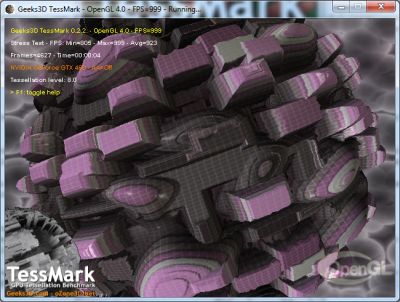
Rule: The higher the number of points, the faster the card is.
Tessellation factor 8.0: moderate
| 52188 (872FPS) – ASUS ENGTX580 |
| 48084 – EVGA GeForce GTX 480 |
| 38191 – MSI GeForce GTX 470 |
| 30512 – MSI N460GTX Cyclone 768D5 OC |
| 26223 – ASUS EAH6870 |
| 24161 (403FPS) – ATI Radeon HD 5870 |
| 20745 – MSI R5770 Hawk |
Tessellation factor 16.0: normal
| 36369 (545FPS) – ASUS ENGTX580 |
| 29196 – EVGA GeForce GTX 480 |
| 23316 – MSI GeForce GTX 470 |
| 17452 – MSI N460GTX Cyclone 768D5 OC |
| 8555 – ASUS EAH6870 |
| 8018 (134FPS) – ATI Radeon HD 5870 |
| 7669 – MSI R5770 Hawk |
Tessellation factor 32.0: extreme
| 15128 (252FPS) – ASUS ENGTX580 |
| 13008 – EVGA GeForce GTX 480 |
| 9997 – MSI GeForce GTX 470 |
| 6729 – MSI N460GTX Cyclone 768D5 OC |
| 2299 – ASUS EAH6870 |
| 2156 (36FPS) – ATI Radeon HD 5870 |
| 2159 – MSI R5770 Hawk |
Tessellation factor 64.0: insane
| 4840 (81FPS) – ASUS ENGTX580 |
| 3963 – EVGA GeForce GTX 480 |
| 3169 – MSI GeForce GTX 470 |
| 1959 – MSI N460GTX Cyclone 768D5 OC |
| 585 – ASUS EAH6870 |
| 565 – MSI R5770 Hawk |
| 550 (10FPS) – ATI Radeon HD 5870 |
3.3 ShaderToyMark (OpenGL 2)
ShaderToyMark 0.1.0 is an OpenGL 2 benchmark, developed with GeeXLab,
and focused on pixel shaders only. The pixel shaders are heavily based on math (few texture fetches) and then ShaderToyMark can be seen as a kind of GPU computing benchmark.
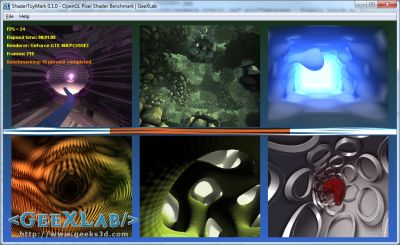
Settings: 960×540 windowed, no AA, 60sec
| 306 points (51 FPS) – ASUS ENGTX580 |
| 263 points (43 FPS) – GeForce GTX 480 |
| 189 points (31 FPS) – ATI Radeon HD 5870 |
| 184 points (30 FPS) – ASUS EAH6870 |
| 156 points (26 FPS) – MSI N460GTX Cyclone |
| 104 points (17 FPS) – MSI R5770 Hawk |
| 46 points (7 FPS) – GeForce 9800 GTX |
| 36 points (6 FPS) – EVGA GTX 280 |
| 33 points (5 FPS) – GeForce GTX 260 |
3.4 OpenGL 4 Mountains demo
Mountains demo is an OpenGL 4 demo that shows hierarchical-Z map based occlusion culling in action.
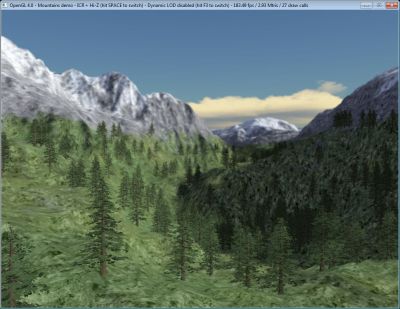
Settings: default window size: 1024×768, ICR enabled (Instance Cloud Reduction), Hi-Z enabled and dynamic LOD enabled.
| 674 FPS – ASUS ENGTX580 |
| 568 FPS – EVGA GTX 480 |
| 350 FPS – MSI N460GTX Cyclone 768D5 |
| 255 FPS – ASUS EAH6870 |
| 231 FPS – Radeon HD 5870 |
| 220 FPS – MSI R5770 Hawk |
3.4 Unigine Heaven (OpenGL 4)
For this last OpenGL test, I used Ungine Heaven 2.1, one of the standard Direct3D / OpenGL synthetic benchmark.
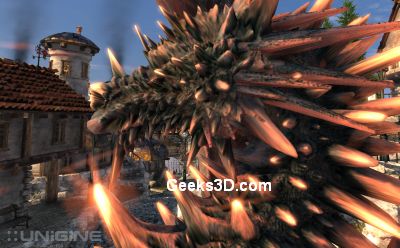
Settings: 1920×1080 fullscreen, OpenGL rendering, tessellation: normal, shaders: high, AA: 4X, 16X anisotropic filtering.
| 46.4 FPS, Scores: 1168 – ASUS ENGTX580 |
| 38.7 FPS, Scores: 974 – EVGA GeForce GTX 480 |
| 24.5 FPS, Scores: 617 – MSI N460GTX Cyclone 768D5 OC |
| 15.9 FPS, Scores: 400 – ATI Radeon HD 5870 |
| 13.6 FPS, Scores: 342 – ASUS EAH6870 |
| 9 FPS, Scores: 227 – MSI R5770 Hawk |
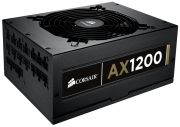
Great stuff indeed! Awesome test JegO! 😉
Some minor mistakes at the parts where you mention Asus Smartdoctor and at 4.5 Direct X SDK.
All this is tesselation is nice and cool, but the problem is that from all these benchmarks you can only actually play LP2 and Hawx and Hawx is running pretty nicely everywhere anyway.
Personally I am having my eyes turned at the 570 or 69XX since the 580 is too expensive for my taste and I am aiming for SLI anyway since I am upgrading from 5850 crossfire and just one card wouldn’t cut it. I will be CPU limited anyway even with the 570s, as were a couple of the tests in this review.
PS Aquamark FTW yay! 😀
Thanks Psolord for the feedback. Mistakes fixed!
wth!! wait till HD6970 launches
bakre ki amma kab tak khair manayegi
Excellent material in this review, but as mentioned by Psolord only two tests are playable games and we would like to see some more heavy game testing; IE. Crysis, Metro2033, Call of Duty: Black Ops, Supreme Commander 2 and so on.
@Krian, @Psolord: I’ll try to improve my next review with some games. Thanks for the feedbacks!
The thing is GTX 580 is the overall best video card ever made giving you an awesome experience of PhysX and DX 11 Tesselation
All hail Nvidia
mighting GTX 580
ati can never overtake the GOD (Nvidia)
@Sachin
In one word, I agree about the 580 being the best card right now. The problem is that it is still slower than the 5970 and that’s a one year old card, not to mention that it’s God awful expensive.
Also there are solutions that are both cheaper and faster right now, like 6870 CFX or GTX 460 SLI.
Now using expression like “all hail Nvidia” and such, quickly demotes you to the fanboy realm.
Pingback: Multipage Post Test: ASUS GTX 580 | JeGX's HackLAB
the problem with real life gaming and benchmarks are really two different things Nvidia cards MIGHT SEEM be slower in a benchmark but what people Really need to remember is games as far back as i can rememeber even that crazy dos version of GTA is FRAME LIMITER when you play games all games are frame limited to 60fps MAX some are still on 30FPS a dvd is 25fps then you must remember ATI or AMD who ever you want to call them is does not work with every title some games need Physic’s or some other instruction that Nvidia can only do,Nvidia offer Compatabilitie
with every game, every application,so that been said there are many games you will get better performance out of because they written the game for Nvidia in mine or they need instruction sets that only Nvidia cards have, the hardware fact is they last far longer then any ATI card I have a TNT card that still works I use that card in a media server as for ATI cards back then no chance.